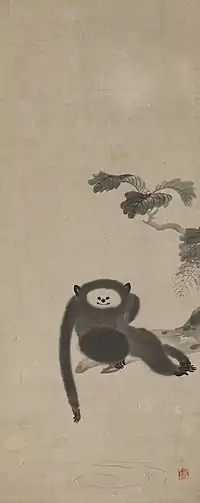.jpg.webp)
Sansetsu's Signature and Seal (山雪筆)

Monkey on a Branch. 1636.
Kanō Sansetsu (狩野 山雪, 1589–1651) was a Japanese painter also known as Kanō Heishiro. He was born in Hizen Province, Kyūshū, and died in Kyoto.[1]
Biography
Sansetsu was apprenticed to Kanō Sanraku, married his daughter, and was adopted by him after the death of Sanraku's eldest son.[1][2] Later, he became the leader of the Kanō school.[2] He was the father of Kanō Einō.
Works
- Dragon in the clouds, hanging scroll, ink on paper.[3]
- Huang Chuping, hanging scroll, ink on paper.[3]
- Laozi, one of a pair of six-panel folding screens, ink on paper.[3]
- Mount Fuji, hanging scroll, ink and gold on paper.[3]
- The old plum ca. 1645, four sliding door panels (fusuma), ink, color, gold leaf on paper.[4]
- Seabirds on a winter coast, screen, color, India ink, and gold on paper. collection hosotsugi, Kyoto.[2]
- The ten snow incidents, one of a pair of six-panel folding screens, ink and light color on paper.[3]
- Transcendent, hanging scroll, ink on paper.[3]
- Two chickens on thatched roof, hanging scroll, ink and light color on paper.[3]
- Xiwangmu (Seiobo), the Queen Mother of the West and Mu Wang (Bokuo), one of a pair of six-panel folding screens, ink on paper.[3]
Gallery
 Frolicking Birds in Plum and Willow Trees, painted on four sliding doors, originally for a room at Myōshin-ji temple in Kyoto. 1631. Important Cultural Property.
Frolicking Birds in Plum and Willow Trees, painted on four sliding doors, originally for a room at Myōshin-ji temple in Kyoto. 1631. Important Cultural Property. The Old Plum, painted on four sliding doors, originally for a room at Myōshin-ji temple in Kyoto. 1646.
The Old Plum, painted on four sliding doors, originally for a room at Myōshin-ji temple in Kyoto. 1646..jpg.webp) Tiger Drinking from a Raging River. Circa 1640.
Tiger Drinking from a Raging River. Circa 1640. Bridled Horse, painted on a wooden ema tablet. 1632.
Bridled Horse, painted on a wooden ema tablet. 1632.
 Winter Landscape. 1615–1651.
Winter Landscape. 1615–1651. Cranes on sliding doors at Yoshimizu Shrine
Cranes on sliding doors at Yoshimizu Shrine Scene from the poem Chang Hen Ge by Bai Juyi (772–846).
Scene from the poem Chang Hen Ge by Bai Juyi (772–846). Owl on the Pine and Chicken on the Bamboo, owl section. Early 1600s.
Owl on the Pine and Chicken on the Bamboo, owl section. Early 1600s.
- Folding screens
.jpg.webp) Waterfowl of the Winter Beach. Folding screen, left panel. 1629. Important Cultural Property
Waterfowl of the Winter Beach. Folding screen, left panel. 1629. Important Cultural Property.jpg.webp) Waterfowl of the Winter Beach. Folding screen, right panel. 1629. Important Cultural Property
Waterfowl of the Winter Beach. Folding screen, right panel. 1629. Important Cultural Property Wang Ziyou Visiting Dai Andao, ink painting on a folding screen. Mid 1600s.
Wang Ziyou Visiting Dai Andao, ink painting on a folding screen. Mid 1600s. A Monk Claps His Hands, ink painting on a folding screen. Mid 1600s.
A Monk Claps His Hands, ink painting on a folding screen. Mid 1600s.
- Chinese figure portraits
 Kongzi. 1632.
Kongzi. 1632. Mengzi. 1632.
Mengzi. 1632. Yanzi. 1632.
Yanzi. 1632. Emperor Yao. 1632.
Emperor Yao. 1632. King Wen of Zhou. 1632.
King Wen of Zhou. 1632. The Duke of Zhou. 1632.
The Duke of Zhou. 1632.
References
- 1 2 "Kano Sansetsu". The concise Grove dictionary of art. Oxford University Press. 2002. Retrieved 2007-11-18.
- 1 2 3 Hetl-Kuntze, H. (1969). Hans L. C. Jaffé (ed.). Far Eastern Art. The Dolphin history of painting. Translated by German Erich Wolf. Thames and Hudson. p. 119.
- 1 2 3 4 5 6 7 8 "MFABoston". Museum of Fine Arts, Boston. Retrieved 2007-11-18.
- ↑ "Attributed to Kano Sansetsu: The Old Plum (1975.268.48)". In Timeline of Art History. New York: The Metropolitan Museum of Art, 2000–. October 2006. Retrieved 2007-11-18.
External links
- Bridge of dreams: the Mary Griggs Burke collection of Japanese art, a catalog from The Metropolitan Museum of Art Libraries (fully available online as PDF), which contains material on this artist (see index)
- The Old Plum, Metropolitan Museum of Art
Wikimedia Commons has media related to Kanō Sansetsu.
This article is issued from Wikipedia. The text is licensed under Creative Commons - Attribution - Sharealike. Additional terms may apply for the media files.